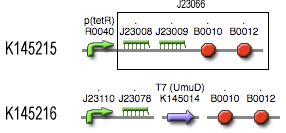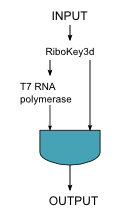Team:KULeuven/Project/Filter
From 2008.igem.org
m (→Components) |
m |
||
| (13 intermediate revisions not shown) | |||
| Line 1: | Line 1: | ||
| + | {{:Team:KULeuven/Tools/Styling}} | ||
| + | {{:Team:KULeuven/Tools/Scripting}} | ||
{{:Team:KULeuven/Tools/Header}} | {{:Team:KULeuven/Tools/Header}} | ||
| - | + | [[Image:pictogram_filter.png|120px|right]] | |
==Filter== | ==Filter== | ||
| Line 10: | Line 12: | ||
===Components=== | ===Components=== | ||
[[Image:T7RNAP.png|290px|right|T7 RNA polymerase, N-terminal pink (front), C-terminal red (back)]] | [[Image:T7RNAP.png|290px|right|T7 RNA polymerase, N-terminal pink (front), C-terminal red (back)]] | ||
| - | The filter | + | The filter acts as a feedforward loop with AND-gate and therefore needs three specific components. |
| - | * The ''first'' is a fast degrading primary messenger. For this, we used [http://partsregistry.org/Part:BBa_J23009 '''BBa_J23009'''], | + | * The ''first'' is a fast degrading primary messenger. For this, we used [http://partsregistry.org/Part:BBa_J23008 '''BBa_J23008''']-[http://partsregistry.org/Part:BBa_J23009 '''BBa_J23009'''], a RiboKey (more information [http://partsregistry.org/Featured_Parts:RNA-Lock-and-Key here]). As this is an mRNA molecule, degradation occurs quite fast ([https://2008.igem.org/Team:KULeuven/Model/Output Reference]). |
| - | * The ''second'' component of the system is a stable secondary messenger, that is induced by the first one. We opted for T7 RNA polymerase ([http://partsregistry.org/Part: | + | * The ''second'' component of the system is a stable secondary messenger, that is induced by the first one. We opted for T7 RNA polymerase ([http://partsregistry.org/Part:BBa_K145001 '''BBa_K145001''']). This molecule is much more stable than mRNA's, and modeling told us it was in fact too stable. So an UmuD derived N-terminal tag was added: [http://partsregistry.org/Part:BBa_K145014 '''BBa_K145014''']. Indeed, the crystal structure of T7 RNA polymerase showed catalytic activity at the C-terminus, which seems to be buried at the inside of the protein. The N-terminal is not catalytically active and also much more accessible. For more information on the UmuD-derived N-terminal tag, see the [https://2008.igem.org/Team:KULeuven/Literature literature]. |
| - | * The ''third'' and last specific component is an AND-gate. To make such a gate, we placed | + | * The ''third'' and last specific component is an AND-gate. To make such a gate, we placed the filter output signal under control of the T7 promoter ([http://partsregistry.org/Part:BBa_I712074 '''BBa_I712074''']) and locked by the RiboLock ([http://partsregistry.org/Part:BBa_J23078 '''BBa_J23078''']). This AND-gate as such is not a part of the filter mechanism, but serves as promoter and RBS of parts that are dependent on the filter. |
===Action=== | ===Action=== | ||
[[Image:filter_1.jpg|140px|left]] | [[Image:filter_1.jpg|140px|left]] | ||
| - | The components mentioned above now work in concert in what is called a coherent feedforward loop with AND-gate ([http://www.nature.com/ng/journal/v31/n1/abs/ng881.html reference]). Its action is particulary dependent on the above-mentioned differences in degradation time of the primary and secondary messenger. If background input signal is present, a small amount of primary messenger will result in a | + | The components mentioned above now work in concert in what is called a coherent feedforward loop with AND-gate ([http://www.nature.com/ng/journal/v31/n1/abs/ng881.html reference]). Its action is particulary dependent on the above-mentioned differences in degradation time of the primary and secondary messenger. If background input signal is present, a small amount of primary messenger will result in a small amount of secondary messenger, but as a result of the time delay between the two, the primary signal will be degraded once the secondary signal is present. Because of this, the AND-gate will give no signal. Given a more decent input signal, the primary messenger will still be present once the secondary messenger is formed. This will lead to a nonzero signal from the AND-gate. |
| - | Indeed, production of the | + | Indeed, production of the RiboKey will result in T7 RNA polymerase production. The T7 promoter and RiboLock together now form the AND-gate, giving final protein output only when both the T7 RNA polymerase and RiboKey are present together. |
| - | For more information on the exact kinetics and dynamics of this system, see the modeling page | + | For more information on the exact kinetics and dynamics of this system, see the ([https://2008.igem.org/Team:KULeuven/Model/Filter modeling page]). |
{{:Team:KULeuven/Tools/Components}} | {{:Team:KULeuven/Tools/Components}} | ||
Latest revision as of 14:50, 3 October 2008
Contents |
Filter
BioBricks
Components
The filter acts as a feedforward loop with AND-gate and therefore needs three specific components.
- The first is a fast degrading primary messenger. For this, we used [http://partsregistry.org/Part:BBa_J23008 BBa_J23008]-[http://partsregistry.org/Part:BBa_J23009 BBa_J23009], a RiboKey (more information [http://partsregistry.org/Featured_Parts:RNA-Lock-and-Key here]). As this is an mRNA molecule, degradation occurs quite fast (Reference).
- The second component of the system is a stable secondary messenger, that is induced by the first one. We opted for T7 RNA polymerase ([http://partsregistry.org/Part:BBa_K145001 BBa_K145001]). This molecule is much more stable than mRNA's, and modeling told us it was in fact too stable. So an UmuD derived N-terminal tag was added: [http://partsregistry.org/Part:BBa_K145014 BBa_K145014]. Indeed, the crystal structure of T7 RNA polymerase showed catalytic activity at the C-terminus, which seems to be buried at the inside of the protein. The N-terminal is not catalytically active and also much more accessible. For more information on the UmuD-derived N-terminal tag, see the literature.
- The third and last specific component is an AND-gate. To make such a gate, we placed the filter output signal under control of the T7 promoter ([http://partsregistry.org/Part:BBa_I712074 BBa_I712074]) and locked by the RiboLock ([http://partsregistry.org/Part:BBa_J23078 BBa_J23078]). This AND-gate as such is not a part of the filter mechanism, but serves as promoter and RBS of parts that are dependent on the filter.
Action
The components mentioned above now work in concert in what is called a coherent feedforward loop with AND-gate ([http://www.nature.com/ng/journal/v31/n1/abs/ng881.html reference]). Its action is particulary dependent on the above-mentioned differences in degradation time of the primary and secondary messenger. If background input signal is present, a small amount of primary messenger will result in a small amount of secondary messenger, but as a result of the time delay between the two, the primary signal will be degraded once the secondary signal is present. Because of this, the AND-gate will give no signal. Given a more decent input signal, the primary messenger will still be present once the secondary messenger is formed. This will lead to a nonzero signal from the AND-gate.
Indeed, production of the RiboKey will result in T7 RNA polymerase production. The T7 promoter and RiboLock together now form the AND-gate, giving final protein output only when both the T7 RNA polymerase and RiboKey are present together.
For more information on the exact kinetics and dynamics of this system, see the (modeling page).
 "
"





 Input
Input Output
Output Filter
Filter InverTimer
InverTimer Reset
Reset Cell Death
Cell Death Memory
Memory